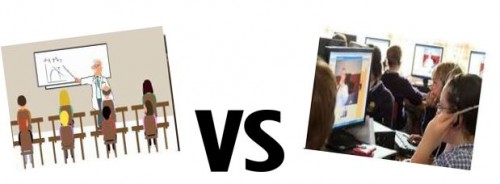Is it time to say farewell to Brick and Mortar class?
Akram BaddouraA growing number of educators argue that the traditional learning approach that takes place inside the class, and is referred to as the “Brick and Mortar” class in which the teacher is the “controller” of the learning environment and the students are recipients, will very soon be a history. These educators assume that due to the fast growing trends in educational uses of technology, the online virtual learning environment, where students are in control of learning at their pace and can learn from anywhere separate from the school, will eventually take over and wipe out the traditional approach. They argue that one of the remarkable contributions of virtual learning environment is that it stands probably, as the only opportunity for people with special circumstances to learn and earn a qualification. The list would include the financially incapable learners, people committed to work and cannot afford to lose the job, professional athletes, rural areas residents, and special needs. Daphne Koller, the co-founder of the Coursera, which is an online education platform that partners with top universities and organizations worldwide, states that the goal of Coursera is “…to take the best courses from the best instructors at best universities and provide it to everyone.” Chief Reporter Sharmila Dhal in Gulf News (2 November 2016), reports that “The rising cost of education is prompting a spike in the number of parents to homeschool their children in the UAE.”
However, opponents of this view consider that the interaction in a real classroom between the teacher and the learner is crucial, indispensable and irreplaceable. They argue that virtual education environment cannot provide that “Humane” interaction between all parties involved in the learning process, whether it is the students, the teacher, the parents, the school counselors and advisors. They claim that the absence of such real interaction would not yield a complete learning process.

The seemingly opposing two learning styles have their characteristics and features. The table below compares between the two styles:
Traditional Learning |
Online virtual learning |
| Focus on the teacher | Focus on learner |
| Structured, restricted, ordered and mostly dependable on teacher | Non-Restricting, flexible, practical, encourages independent work, and accessible at any time and from any place |
| Always Synchronous | Could be Synchronous or Asynchronous |
| Communication flows mainly in one direction | Two-way interaction |
| Active for teacher, passive for learners
|
Active for learner; encourages collaboration and discussion amongst learners |
| A transfer of knowledge | Exchange of knowledge, ideas, and opinions |
| Financially expensive | Cheaper than physical schooling |
| lower critical thinking skills | Triggers high critical thinking |
| Teacher is “Controller” of learning process | Student is an active partner in the process |
A question to ask would be whether the existence of one prohibits the need for the other! Or, perhaps we should ask whether both learning environments could join forces in an ideal combination, namely, the blended learning approach. It is that hybrid style that encompasses both, the traditional in-class face-to-face learning and the online virtual learning environment.

Resources
Dhal, S. (2016, November 2). Home schooling on the rise in UAE as educational costs go up. Retrieved from https://gulfnews.com/xpress/news/home-schooling-on-the-rise-in-uae-as-educational-costs-go-up-1.1923116
Koller, D. (2012, June 15). What we are learning from online learning. Retrieved from https://www.ted.com/talks/daphne_koller_what_we_re_learning_from_online_education#t-145627
https://www.coursera.org/learn/virtual-school
https://education.seattlepi.com/advantages-traditional-schools-2140.html
https://www.mindflash.com/elearning/what-is-blended-learning/
https://www.learndash.com/characteristics-of-a-virtual-classroom/